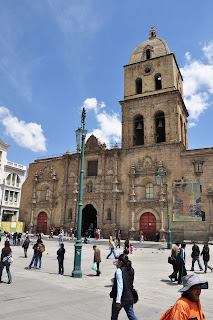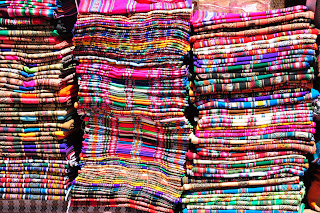On Friday morning, our Personal Guide Haime, transferred us to the Santiago Airport so that we could embark on our next adventure in La Paz, Bolivia. Following an approximate four hour LAN flight to La Paz, we were greeted at the La Paz Airport by our Personal Guide Juan Carlos. La Paz was the one destination I was initially a little wary of with stories of robberies left right and centre, express kidnappings, being held hostage for days until one’s bank account was emptied via elaborate false Police and Taxi Driver scams, the ready availability of cocaine and associated criminal activities not to mention the potentially fatal altitude sickness. So, when Juan Carlos advised us that there was going to be an approximate three hour delay in transferring us to our hotel due to a protest and resultant blockade, I thought “here we go”! Upon further investigation, I became aware that the protest was in fact a peaceful one about the education system, and that Juan Carlos was simply doing his job by erring on the side of caution. It was at this moment that I already liked the Bolivians as they are passionate and stand up for what they believe in, much like me. As for the other stuff, I categorise these as urban myths or experiences that silly people have when they don’t tread lightly and travel safely, as Lonely Planet prescribes. I firmly believe that when one travels South America or anywhere in style as we are, one can only have a fabulous experience.
Back to killing time at the airport until the protest subsided, Juan Carlos gave us some sound advice on travelling in Bolivia over a notorious cocoa tea which is a completely legitimate herbal remedy in Bolivia to prevent the onset of altitude sickness symptoms, but considered by some countries to be simply a precursor to cocaine. In addition to cocoa tea, the three key recommendations provided by Juan Carlos to prevent altitude sickness are: Eating lightly and drinking at least two litres of water per day; doing everything slowly until one is acclimatised to the altitude; and sleeping alone! Furthermore, that one is to “eat breakfast like a King, lunch like a Lord, and dinner like a beggar” as the high altitude can hinder the digestion process in the evenings. Some other interesting Bolivian travel advice provided by Juan Carlos included that one should always seek a Bolivian (Aymara) woman’s permission before taking her photograph as many believe that the act of photographing steals their souls, and that in terms of cuisine, Bolivia is renowned for its beef, spicy foods (i.e. A spicy sauce comprising finely chopped tomatoes and onions or other variations referred to as “pecente” and carbohydrate combinations (i.e. Rice with potatoes and pasta with potatoes). Another interesting Bolivian fact courtesy of Juan Carlos, was that they once had McDonalds here. One of the key reasons that McDonalds is no longer in Bolivia, is because it was bringing in ingredients such as potatoes from the United States, albeit Bolivia is one of the key producers of potatoes. Accordingly, the Bolivians increasingly refused to dine at McDonalds and the decision was made to cease its operations here. Burger King on the other hand prospers in Bolivia, as they use local ingredients such as potatoes.
The opportunity to speak with Juan Carlos at the Airport during the delay was a lovely interlude and once the protest had finished, we drove to our Hotel Rosario. The view of La Paz from a stop off on the way was breathtaking and as we neared our four star hotel in upmarket strip Illampu Avenue, the stark contrast between the rich and poor here was already becoming apparent with humble street stalls and their equally humble proprietors lining the avenue. Upon checking in, Nige and I began to experience mild altitude sickness symptoms such as headache, difficulty breathing and tingling hands and feet, which is pretty good considering we were at about 3,600 metres above sea level. As such we decided to enjoy dinner at the hotel restaurant before an early night. Taking on board Juan Carlos’ advice about a light dinner, I had the pleasure of sampling a traditional Bolivian Chairo, for only AUS$6.00. Chairo is a typical soup of the high plateau region with chuno (dried potatoes), wheat and dried salted lamb with Andean herbs. It was simply divine!
Waking up on Saturday feeling much more refreshed after the Chairo and a beautiful buffet breakfast at the hotel, Nige and I were feeling excited about our stroll through the city centre in the morning and official tour of the city hosted by our other Personal Guide Carlos.
First up was a visit to the famous “Witches Market”, a street containing very colourful stalls upon stalls of little wonders including handicrafts, jewellery and accessories. Nige and I were very proud of ourselves here bargaining down several purchases, including a handbag, in Latin Spanish. We then battled the crazy traffic of miscellaneous vehicles and pedestrians to check out the beautiful Cathedral Square before returning to the hotel to embark on our city tour with Carlos.
We learnt some interesting facts about La Paz from Carlos during the tour including that: La Paz once had a river full of gold; fruit and vegetables are grown in the mountain fields and brought to the central markets twice a week which is why there’s always an abundance of fresh fruits and vegetables, the notable “Moon Valley” was named by Neil Armstrong due to the moon crater like formations of the mountains; Saturday is the day for weddings where it is customary for newlyweds to cross a bridge and sun and rain at the same time suggests that an older person is marrying a younger person; about 80 per cent of vehicles are Toyota as they’re built tough; and some of the best Bolivian wines and restaurants respectively are Campos de Solana and Marvella. It was also observed during the tour that the traditional dress, poncho and hat otherwise known as “Chola” worn by Bolivian women is becoming extinct as the next generations of women are wearing western clothes like jeans. The perfect end to the perfect day was a 180 degree view of La Paz from a hilltop and an early non-traditional dinner of lasagne and garlic bread at the hotel restaurant.
It was like Christmas morning for Nige on Sunday with the impending tours of the Tiwanaku and Puma Punku pre-Inca ruins. Nige has wanted to see these ruins since he was a teenager. While these tours were mainly for Nige’s benefit, I found them to be fascinating and happened to learn during these tours that the main wine region of Bolivia is Tarija. While photos weren’t allowed in the Tiwanaku museum due to the strict preservation rules surrounding the artefacts, unlimited photos were allowed on the actual Tiwanaku site. The aspect that I found most interesting about the Tiwanaku ruins is all the various theories deduced from the many discovered artefacts in the absence of anything written. For example, it is said of the underground temple featuring stone carvings of people’s faces, that the high priests sent special people overseas for four to six years, after which time they were to return and report back on what people looked like overseas to carve out their faces. It was also great to see the Puma Punku ruins which unlike the more established Tiwanaku ruins are much more of a mystery, as they have not been touched since 1965. After a big day of history lessons, we had a light lunch at the Angelo Colonial to pave the way for our last dinner in La Paz.
The things I most enjoyed about La Paz were:
- The allure of the cocoa tea;
- The passionate nature of Bolivian people and culture and their pride in history and tradition;
- Bolivian cuisine such as Chairo;
- Our boutique, four star Hotel Rosario, which is decked out in traditional décor such as artwork containing little colourful cloth dolls;
- The colourful and mysterious Witches Market;
- The literally breathtaking views of La Paz from hilltops;
- The hustle and bustle of the street stalls; and
- The puzzles of the Tiwanaku and Puma Punku ruins
I strongly recommend that people travel to Bolivia, La Paz in particular, to see how incredible it is.
 |
| Nige and our Personal Guide Carlos |
 |
| The architecturally sound San Francisco Cathedral in the square |
 |
| The view of the Spanish inspired courtyard at our Hotel Rosario |
 |
| The fabulous view of La Paz from a hilltop |
 |
| Colourful scarves on display at the Witches Market |
 |
| A wonderful little cafe we discovered at San Francisco Square |
 |
| A shot of the Witches market where an Aymara woman can be observed wearing the Chola |
 |
| A discovered stone carving at the Tiwanaku ruins |
 |
| Another discovered stone carving at the Puma Punku ruins |
0 comments:
Post a Comment